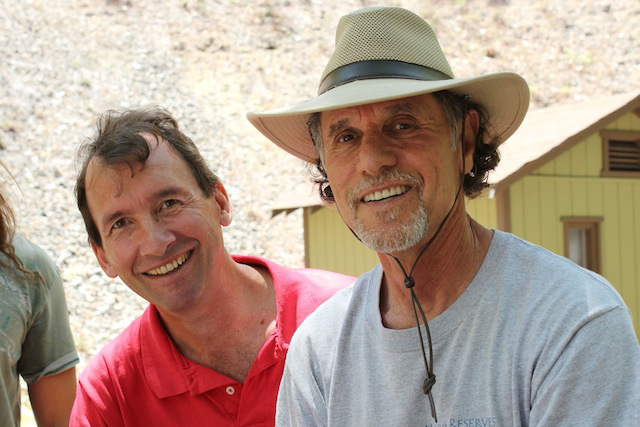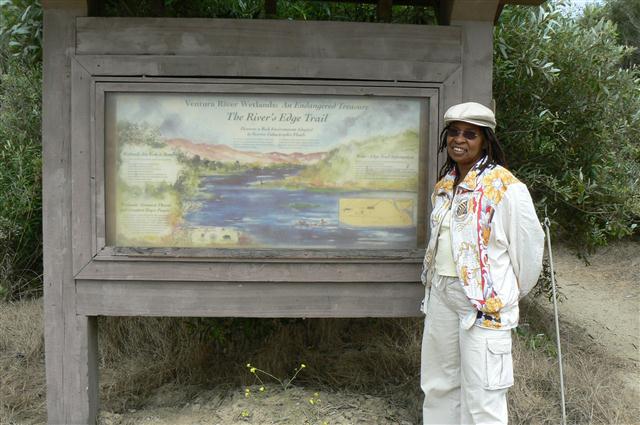 |
Elderberries develop a whitish bloom
and hang in heavy clusters when ripe |
Got Elderberry?
Find detailed directions for extracting Elderberry juice in this HerbBlog article
Fresh Elderberry juice is one of Nature’s most delicious rewards for our foraging efforts. Elderberry harvesting season is here now; in fact, for those of us in the inland valleys of Southern California it’s already been here and gone due to the drought-like conditions this year. Last week, though, I managed to find a couple of trees loaded with ripe berries in the Upper Ojai Valley. Your best bet now is to look closer to the coast or along creeks and rivers that empty into the ocean where you’ll find there are still plenty around.
WARNING: All parts of the Elderberry plant are toxic except for the flowers and ripe fruits. Like all Elderberry trees, our local species,
Sambucus nigra ssp. caerulea, also known as Blue Elderberry, contains hydrocyanic acid and sambucine, a poisonous alkaloid. These are concentrated in the woody parts, seeds, stems, and leaves and can cause symptoms closely resembling symptoms of intoxication, nausea, intestinal issues, and possible cardiac arrest. Some people experience nausea or diarrhea from ingesting the raw berries but, most likely, the seeds are the culprits. According to the USDA and others, the ripe berries are edible but many sources recommend using only cooked or dried berries.
Read the entire article here. |
 |
Dr. Jim and Lanny are all smiles
back at the Visitor Center
|
Another great day with Jim Adams
Our biggest turnout of the year!
Dr. James Adams of the USC School of Pharmacology returned to Wheeler Gorge for his fourth joint venture with Herb Walks on Sunday, June 16.
As before, his unique blend of academic knowledge, hands-on experience, and heartfelt spirituality captivated the crowd who came from all over Southern California.
We started out in the forest on the North Fork of Matilija Creek where Jim demonstrated responsible and traditional use of White Sage for blessing, as taught to him by the late Cecilia Garcia.
On the trail, Jim and I identified and discussed 14 native trees and plants before the group returned to Wheeler Gorge Visitor Center to prepare acorn mush from acorns I harvested last fall.
Everyone helped out with the shelling process to reveal the vibrant yellow nuts inside.
Jim demonstrated his 21st century methods of acorn preparation, producing the fragrant acorn meal that was cooked into porridge.
I hope to use the August break to write about this year's Medicinal Plant Walks with Professor Adams and share more photos, so please check in at the HerbBlog from time to time.
(Photos by Keith Farrar)
|
|
Beach Evening-Primrose
flowering among the Beach Bur
at Seaside Wilderness Park
July Schedule
|
The Book-of-the-Month for July and August
It's a must-read reference for foragers
'Tis the season of the year for harvesting many wild foods, especially fruits, nuts and seeds. So now is the time to add a reference book like Charlotte Bringle Clarke's classic to your library.
Edible and Useful Plants of California is published by the University of California Press as one of their California Natural History Guides.
To quote the back cover: “Both American Indians and the pioneers knew and used many different plant species — for food, fibers, medicine, tools, and other purposes. This unique book is a guide to identifying more than 220 such plants. But it goes much further — it also tells the reader how to prepare, cook, and otherwise use them. Some of the dishes for which recipes are given have won culinary prizes. All have been tested not only by the author but also by her students and journalists — who have been uniformly surprised and impressed.
The plants are organized by habitat communities. Descriptions, photos, drawings, and distribution information are given. Where poisonous look-alikes exist they too are illustrated. Much fascinating information about Indian uses of native and introduced species is included.
The author emphasizes conservation considerations: the aim of the book is to educate the reader about intriguing uses of the plants, and to tell how to gather and use the most palatable and abundant species without damaging the environment.”
By purchasing this book from the Herb Walks Store, you are supporting Herb Walks and the HerbWalks.com website. Thank you!
|
My Favorite Links
All together now, to the tune of "My Favorite Things" from Sound of Music.
Raindrops on roses and edible fungus
Secrets of nature found hiding among us
Websites where you can see Indian Pinks
These are a few of my favorite links
|
|
 |
| Lanny (facing camera) with group on the Ventura River
(Photo by Kimber Mahon) |
Kaufer's Kontest
Everyone who enters is a winner this month! Read on to found out more.
Before we get to this month's brand new Kaufer's Kontest, here's a hearty shout-out to Avery Hardy who took on the challenge of last month's Kaufer's Kwiz treasure hunt and found the answer to the question at the end of the hunt. The question in question involved naming the 3 anti-inflammatory compounds found in a mystery plant. The plant turned out to be Black Sage and the 3 compounds are diterpenoids, aethiopinone and ursolic acid. Congratulations to Avery and everyone else who played. I hope you had fun.
This month I'm trying something different: a writing contest. Here's how it works. Write a short (100-200 word) "review" of your experience(s) attending one or more Herb Walks, describing what you liked, what you learned, and how you have applied what you learned in your own life. The reviews will be read by a panel consisting of me, my wife Rondia, and Keith Farrar, who has attended several Herb Walks and won the June 2013 Kwiz.
The contest is open until July 31 and the prize is a free Herb Walk. The winner will be notified during the first week of August and the winning review will be published in the September newsletter.
Plus, as an added incentive, EVERYONE who submits an entry that meets the criteria above, will win a bar of Violet's Handmade Soap, redeemable at your next Herb Walk or added to your next order from the Herb Walks Store.
Please send your reviews to lanny@herbwalks.com. |
|
 |
| Rondia at the River's Edge Trail |
We're heading to the beach in July. You in?
This is where the Chumash went in July and August when Ojai got too hot
Discover the variety of native plants that live in the interface between land and sea. We will park on the far end of West Main Street in Ventura, just before it enters the northbound 101 to Santa Barbara, outside the entrance to Seaside Wilderness Park, also known as Emma Wood Group Camp (NOT the Emma Wood Beach RV Camp which is further on under the overpass). You are welcome to drive into the Group Camp to park but it costs $10.
From there, we will walk into the Group Camp and start the walk on the River’s Edge Trail at the east end of the Group Camp. We’ll start by walking through the Ventura Rivermouth and Estuary identifying and learning about the plants and complete the loop on the Ocean’s Edge Trail in the sand dunes on the beach. We will be discussing and demonstrating uses of the plants of the Riparian Woodland, Coastal Sage Scrub, and Coastal Strand plant communities, all of which can be found in Seaside Wilderness Park.
You can register here right now or return later to the event page to sign up and read all the details. Just remember, this is the the last walk until mid-September.
 |
| Datura standing its ground amid invasive Nasturtium and Mustard at Emma Wood Group Camp |
|
|
